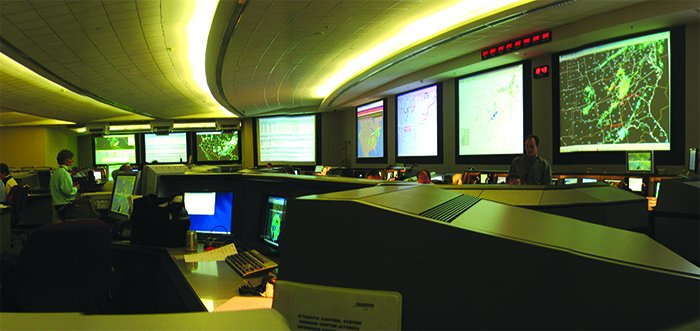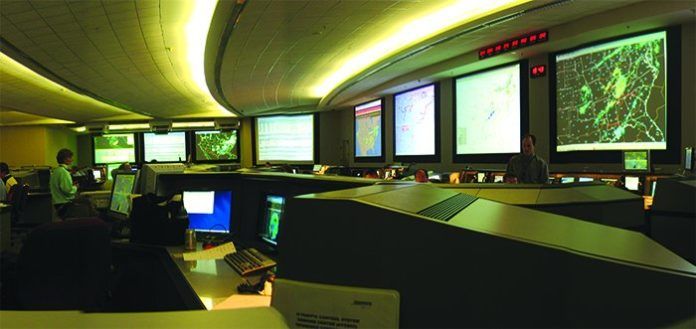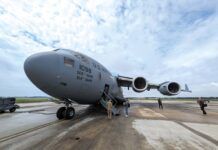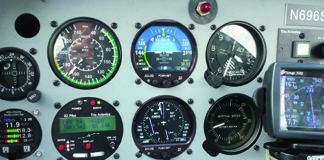As pilots or passengers, we fly to go somewhere. That “somewhere” isn’t on an airport ramp, crammed for hours into a stationary airliner. And it’s not cooling your heels in the runup area with the engine shut down.
No one likes to experience aviatus interruptus. A delay is a strong sign that your destination, or a facility along your route, is reaching—or has exceeded—its maximum safe capacity.
Picture one of those champagne glass towers at a swanky party in a Hollywood movie. The matre d’ pops the cork, pours it into the top glass, the top glass overflows, and it runs down into the lower glasses. That pyramid of glass is the National Airspace System. The bubbly of course represents all of the thousands of airplanes flowing through the NAS at any one time. The lowest tier of glasses is the airports. Above that are the Terminal Radar Approach Controls (TRACONs), then the Air Route Traffic Control Centers (ARTCCs).

Controllers manage the flow of aircraft between each of the glasses in their layer and the layers above and below their own. However, every one of those glasses has a finite capacity for airplanes. Exceeding it in one can cause a ripple effect that will affect the others in its proximity, and even across the country. To prevent this, the NAS has many procedures in place to preserve safety and order and prevent traffic overflows.
Unfortunately for pilots and their passengers, delays are one of those procedures.
It’s All About Having Space
To paraphrase the late Douglas Adams, the “sky is big.” Unfortunately, the airports below are not quite so fortunate. A typical runway peaks at around 60 operations per hour. That’s one arrival or one departure every minute, in ideal VMC and with no heavy wake-turbulence aircraft.
Multiply that by the number of runways and that’s the number of ops an airport can accommodate per hour. More runways mean more throughput. Miami (MIA) has three parallels. Atlanta-Hartford (ATL) has a whopping five. For efficiency, ATC can delegate certain runways for arrivals and others for departure. While an aircraft is landing on one runway, a departure is taxiing into position on another, ready to go.
ATC’s standard arrival or departure separation is a minimum three miles between airplanes unless lengthened by wake-turbulence requirements.
Visual separation is used to run them more tightly together. If ATC transmits, “Citation Six Bravo Alpha, follow the Boeing 717, caution wake turbulence, cleared Runway 25 visual approach,” the Citation can follow the B717 as closely as the pilot deems safe.
Now a line of thunderstorms trundles into the area. The visibility and ceiling drop to IMC. Blood pressure in the cockpit, the Tower, and the radar room takes a collective spike. The airplanes can’t see each other, the Tower can’t see the airplanes, and visual separation is unusable. ATC needs the minimum three miles between airplanes. Depending on how bad the weather gets, capacity can drop 50 percent. That’s 30 planes per runway that can’t get in or out.
While nature certainly has its unavoidable effect on airline schedules, often it’s the air carriers themselves that are the problem. Take a major hub airport with two active runways and 10 airlines, each which schedule an average of 15 arrivals or departures an hour; that’s 150 operations scheduled for an airport than can only accommodate 120.
Those 30 extra airplanes need to go somewhere. Often the Center or TRACON radar controllers will put them into holding patterns until the destination airport frees up some room. If weather is a factor and isn’t improving, some may divert to their alternates. All the while, more airplanes are flowing in.
Now the radar controller has airplanes stacked in holds, nasty weather in the area, and more traffic inbound. When that destination airport or radar sector is reaching its safe limit, it’s time for the facilities feeding that airport or sector to cut back on the flow.
Looking Into ATC’s Crystal Ball
How do ATC facilities know when they’re about to get hit with a lot of traffic? It falls to Traffic Management Units (TMUs) and their metering systems to predict when that big sky is going to get cloudy with airplanes.
TMUs are specialized departments within all Centers and larger Approach Controls that develop an overall picture of how many planes a facility has in its airspace and how many more they are expecting. They employ several software applications that allow Traffic Management Specialists to visualize both current and expected traffic data and adjust staffing to meet that traffic.
One of the Center TMU programs is the Traffic Situation Display (TSD), an electronic map depicting all of the facility’s sectors. Sectors flash yellow when they near their traffic limits, turning red when they become overloaded.
As the traffic builds, each sector’s controller may be given help. That can involve lending him a second pair of eyes and hands in the form of an assistant D-side (data) controller, or splitting the sector between him and another regular controller on another, separate scope.
There’s only so much that additional manpower can do (and current ATC staffing numbers may not permit that help anyway). At a certain point, TMUs may institute flow programs. Among the most common are “miles in trail” requests. Instead of the normal five miles of separation tail-to-nose, controllers feeding aircraft to the “red” sector are required to space their aircraft 10 or 20 miles apart before passing them on.
But even flow control programs can do only so much before broader, national steps need to be taken.
Bargaining with Big Brother
Let’s keep running with that champagne-glass tower analogy. If the Towers, TRACONs, and Centers are the glasses, then the Air Traffic Control System Command Center (ATCSCC) is the matre d’ with the bottle in hand. He can examine the glasses, see which ones are getting full or empty, and decide to pour the Cristal in one column or another. Or he can choose to cut it off altogether. He’s got the biggest picture of all, and it’s his role to manage that flow.
The ATCSCC staff members are observers and dealers. Their tools are conference calls, monitoring systems, and delay programs. Many of the programs they use, such as the TSD, are similar to those used by facility TMUs but display a larger scale. Their role is to identify congestion points in the entire NAS and take appropriate measures to alleviate them.
For instance, if they predict one airport—say Atlanta—is going to get slammed with weather or traffic, they’ll set up a conference call with several airlines to determine which of their flights are most critical, and which can be delayed. Suppose Delta’s Flight 1794 is a 757 that will be flown on four flights around the country today. All of those flights will be delayed if the initial one out of ATL is delayed. Given the potential impact, it takes precedence over a regional jet that was going to be used for a short there-and-back hop to Charlotte, N.C. So, the 757 gets to go but the RJ stays on the ground for the moment.
It’s all about the lesser of two evils. The airline can either piss off a few passengers and one flight crew, or piss off a lot of passengers and several crews. When a flight is delayed, the order to keep it grounded originated with the ATCSCC. Don’t hate them. It’s their job, and it’s in the name of safety. An overloaded airport or radar sector is a dangerous one.
The ATCSCC also has a significant role in responding to emergency and national security situations. The most prominent example, of course, is the grounding of all air traffic on the morning of September 11, 2001. No departures were allowed, every aircraft had to land, and every inbound international flight had to divert to another country.
You’re Not Going Anywhere
The actions taken on 9/11 were a hyperbolic example of one of the ATCSCC’s tools: the Ground Delay Program (GDP), commonly referred to as a ground stop. The simple fact is that an airplane sitting on the ground is far less complicated to handle than one ripping through the sky at 500 knots.
When a flight’s destination is expected to reach saturation and is refusing anymore “business,” keeping potential arrivals grounded naturally reduces congestion. The receiving Tower, Approach, and Center controllers can catch their breath and get their existing inbounds and departures out of the way. All the while, the word “delayed” starts popping up beside scores of flights on arrival/departure screens in airport terminals throughout the country.
Sometimes the ATCSCC wants only select flights to be held on the ground. Those flights will be issued an Expect Departure Clearance Time, or EDCT (pronounced “edict”), which is automatically assigned by the ATCSCC’s Traffic Management System computer.
The EDCT is a time slot that gives the flight crew, the airline, and the Tower controllers an idea of when the flight can expect to depart. It could be 15 minutes after its scheduled time, or hours after it. It can also change several times depending if conditions at the destination are improving or deteriorating.
If the EDCT is shortly after the flight’s scheduled departure time, the flight may board its passengers and taxi to a temporary parking spot to wait—hopefully not for seven hours with nothing but peanuts and a broken lavatory.
If the delay is expected to be a long one, the airline might delay boarding. It keeps the passengers in the more spacious airport terminal and the crew from burning duty time in the cockpit.
As listed in AIM 5-2-6, aircraft can only depart within the five minutes before or after their EDCT. Due to this restriction, pilots and Tower controllers are typically in close communication regarding EDCTs and do their best to taxi the aircraft to the runway with time to spare. Missing that window is more headaches for everyone.
Clearing the Air
Whether you’re nursing an overpriced frosty beverage at the terminal bar, rereading the misnamed “in-flight” magazine while ground stopped on the furthest corner of the airport ramp, or sitting at the FBO watching the flying day creep by on the clock, consider this: Would you rather be waiting on the ground, or in an overcrowded sky headed towards an overcrowded airport run by overworked controllers?
Along those lines, those of us on this side of the scope are well aware of the bait-and-switch technique some GA pilots will use to get around ground stops. They file for a less-congested airport and then change destinations in the air to jump in sequence at the overloaded airport. I’m not saying this will or won’t work, but know that it makes you as popular with controllers as that guy who zipped down the empty lane on a highway merge and is now trying to muscle in at the end.
Sometimes, no matter how big the sky is, there’s just nowhere for you to go. Remember the old adage: “It’s better to arrive late than not at all.”
Tarrence Kramer juggles as many planes as he can from a scope in the southeastern U.S.





